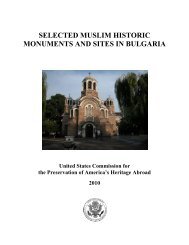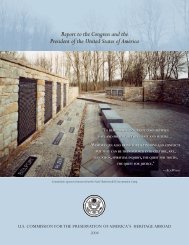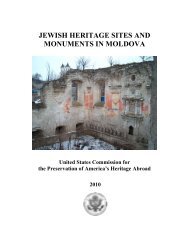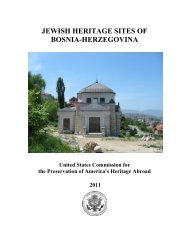jewish cemeteries, synagogues, and mass grave sites in ukraine
jewish cemeteries, synagogues, and mass grave sites in ukraine
jewish cemeteries, synagogues, and mass grave sites in ukraine
You also want an ePaper? Increase the reach of your titles
YUMPU automatically turns print PDFs into web optimized ePapers that Google loves.
environment be natural. This tradition expresses the futility of oppos<strong>in</strong>g the changes of nature.<br />
However, it has been traditional for Jewish communities to carry out rout<strong>in</strong>e clean<strong>in</strong>g <strong>and</strong><br />
clear<strong>in</strong>g of vegetation at <strong>cemeteries</strong>, <strong>and</strong> to undertake remedial work when <strong>cemeteries</strong> have<br />
suffered from destruction <strong>and</strong> subsequent neglect.<br />
Removal of vegetation often requires approval from both secular <strong>and</strong> religious authorities. Many<br />
Jewish <strong>cemeteries</strong> <strong>in</strong> Ukra<strong>in</strong>e are now classified as woodl<strong>and</strong>, <strong>and</strong> removal of trees that have<br />
grown up on the site <strong>in</strong> the past half-century, such as the nearly 2,000 sapl<strong>in</strong>gs <strong>and</strong> p<strong>in</strong>e trees on<br />
the cemetery <strong>in</strong> Brody, require permission from forestry officials.<br />
Likewise, if removal of vegetation <strong>in</strong>volves any excavation (as opposed to cutt<strong>in</strong>g), even trees<br />
that are threaten<strong>in</strong>g <strong>grave</strong>s with their root structure, rabb<strong>in</strong>ic approval or, even, religious<br />
supervision may be required to ensure that <strong>grave</strong>s are not disturbed.<br />
The presence of large trees often provides aesthetic relief. However, it is sometimes necessary,<br />
as at Zhytomyr, to cut trees down because they are damag<strong>in</strong>g <strong>grave</strong>s or because the danger of<br />
their collapse is deemed a safety hazard.<br />
The Talmud is specific <strong>in</strong> stat<strong>in</strong>g that animals should not be pastured nor grass collected <strong>in</strong> a<br />
cemetery. Yet, if any one collected grass, it had to be burnt immediately out of respect due to the<br />
dead (Sanhedr<strong>in</strong> 46a.).<br />
In <strong>cemeteries</strong> that have long been ab<strong>and</strong>oned, however, it is commonly accepted that clear<strong>in</strong>g of<br />
vegetation is required <strong>in</strong> order to reveal <strong>and</strong> protect the <strong>grave</strong>s <strong>and</strong> stones. Likewise, for the<br />
ma<strong>in</strong>tenance of a cemetery, it is commonly arranged that a local farmer may clear hay.<br />
Although, <strong>in</strong> many <strong>in</strong>stances, local peasants or collectives allow animals to graze on Jewish<br />
<strong>cemeteries</strong>, <strong>and</strong> this graz<strong>in</strong>g controls the vegetation, Jews generally prefer to erect fences to<br />
protect <strong>sites</strong> from animals as well as from humans.<br />
In Podillia (the region of southwest Ukra<strong>in</strong>e formerly part of southeastern Pol<strong>and</strong>), many historic<br />
<strong>cemeteries</strong> still ma<strong>in</strong>ta<strong>in</strong> some of their orig<strong>in</strong>al decorated tombstones. In Buchach (Ternopilska<br />
oblast), some tombstones date back to the 16 th century, <strong>and</strong> several from the 17 th <strong>and</strong> 18 th<br />
centuries are noteworthy for their marvelous portal shape construction <strong>and</strong> <strong>in</strong>terest<strong>in</strong>g texts. The<br />
<strong>in</strong>scriptions at Buchach are particularly <strong>in</strong>formative from an historical po<strong>in</strong>t of view; the<br />
genealogical <strong>in</strong>formation reveals much about the migration of the Jews <strong>in</strong> this area.<br />
The known cemetery <strong>sites</strong> can be classified <strong>in</strong>to the follow<strong>in</strong>g categories:<br />
‣ Cemeteries where the general location is known, but which are not <strong>in</strong> any way marked,<br />
<strong>and</strong> which have been developed for some other use. Typical examples <strong>in</strong>clude the old cemetery<br />
at Brody (Lvivska oblast) that is used as a football field, <strong>and</strong> <strong>cemeteries</strong> at Drohobych <strong>and</strong> Stryj<br />
(Lvivska oblast), where apartment build<strong>in</strong>gs are built.<br />
‣ Cemeteries where the boundaries are known, but an <strong>in</strong>appropriate activity takes place.<br />
This is the case with the old <strong>cemeteries</strong> <strong>in</strong> Zhovkva <strong>and</strong> Lviv (Lvivska oblast), where markets<br />
take place with<strong>in</strong> the cemetery walls. In Zhovkva, there are a few permanent structures on the<br />
site. In Lviv, a bustl<strong>in</strong>g marketplace with many new build<strong>in</strong>gs occupies the cemetery <strong>and</strong><br />
considerable area beyond (figures 14-17).<br />
49









